VHT-1(A1,A2,A3) "SPARTAS" VERITECH HOVERTANK
(Version 2.00 - Last updated:
08/07/03)
- Background and RPG Statistics by Kenneth
Olson
- Background Information derived from Robotech
Technical Files
and
Robotech.com
-
Robotech Research Picture archive for
VHT-1 "Spartas"
BACKGROUND
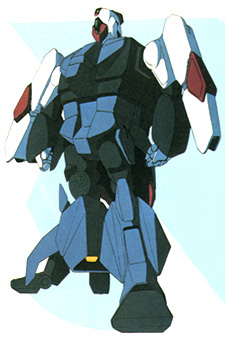 The
VHT-1 “Spartas” was developed by the United Earth Government in 2015 to fill the
armored reconnaissance role, a role which had previously been carried out by the
VBT-1 "Centaur";
however, by 2015 technological improvements had made the design dangerously
obsolete. The new design was required to have superior maneuverability over the
older RDF Destroid and VBT-1 “Centaur” models but retain the armor and firepower
to directly confront the most powerful Zentraedi mecha. Two designs were placed
forwarded as prospective candidates. The first was an upgraded version of the
venerable Centaur, dubbed the VBT-1A1 “Centaur-II” and the other was the VHT-1
“Spartas” hovertank. Although the Centaur-II provided protection for the crew
in all modes and possesses slightly greater firepower, the VHT-1 “Spartas”
ultimately won the competition with its greater maneuverability and dedicated
battloid mode.
The
VHT-1 “Spartas” was developed by the United Earth Government in 2015 to fill the
armored reconnaissance role, a role which had previously been carried out by the
VBT-1 "Centaur";
however, by 2015 technological improvements had made the design dangerously
obsolete. The new design was required to have superior maneuverability over the
older RDF Destroid and VBT-1 “Centaur” models but retain the armor and firepower
to directly confront the most powerful Zentraedi mecha. Two designs were placed
forwarded as prospective candidates. The first was an upgraded version of the
venerable Centaur, dubbed the VBT-1A1 “Centaur-II” and the other was the VHT-1
“Spartas” hovertank. Although the Centaur-II provided protection for the crew
in all modes and possesses slightly greater firepower, the VHT-1 “Spartas”
ultimately won the competition with its greater maneuverability and dedicated
battloid mode.
The VHT-1 “Spartas”, like most of the other variable
fighter designs, has three modes each of which fulfills a different role for the
unit. The hovertank is used when the unit is operating in its reconnaissance
role and provides the Spartas with the highest speed and greatest
maneuverability. The while in hovertank mode the Spartas is powered by four
Pratt and Whitney HJ-800 fanjets, which propels the mecha to speeds up to 161
kph. The guardian, also known as tank, configuration sacrifices speed but
allows the unit to fire its 105mm smoothbore cannon with improved accuracy and
allows the autoloaders to reload the weapon. Finally battloid mode, gives the
Spartas all the advantages of a humanoid form.
The Spartas is armed with an impressive load out of direct
attack weaponry. The primary weapon for the VHT-1 is a 105mm smoothbore cannon
mounted in an armored housing on the right arm. The 105mm cannon can only be
fired while the mecha is in guardian or battloid mode. Ammunition is supplied
to the cannon via an autoloader which is only functional while the Spartas is in
guardian mode. Hence, while in battloid mode the mecha can only fire the shell
that is currently loaded. The type of ammunition is chosen by the pilot or
picked automatically by the onboard computer with the autoloader providing up to
20 shells per minute.
The left armored housing mounts an Oerlikon PP-36
triple-barreled plasma pulse cannon capable of firing 5 MJ bursts of
annihilation disks, similar to those found on Invid mecha, out to an effective
range of 1200 meters. The weapon is provided plasma directly from the main
protoculture energizers, which allows the weapon to fire up to twenty bursts per
minute. Unlike the 105mm smoothbore, the PP-36 can fire either in battloid or
guardian without penalty but cannot be used in hovertank mode.
The primary weapon of the VHT-1 in battloid is a single
EU-11 laser gun pod, which is carried in either arm and mounted in the center of
the unit while in hovertank. The EU-11 cannot be used while the Spartas is in
guardian, as it is mounted underneath and blocked by the units internal
structure. The EU-11 is powered directly from the main protoculture energizers
and can fire 13.5 MJ bursts of laser energy out to an effective combat range of
3.5 km.
The Spartas was armored with the latest generation of
Chobham low-mass composite plate providing immunity from all anti-personnel and
light anti-mecha weaponry. The armor was so resistant that the unit could be
disabled only by multiple hits from medium (55mm) or heavy anti-mecha weaponry.
In addition to the heavy armor, the Spartas was provided with two heavily
armored arm shields in which the 105mm smoothbore and PP-36 cannons were
mounted. These arm shields could be used to parry incoming attacks while the
Spartas is in battloid mode and are capable of deflecting attacks that could
penetrate the main armor and thus disable the unit. The heavy armor and arm
shields give the Spartas nearly 50% the armor protection over the earlier RDF
series of Destroids.
The VHT-1 “Spartas” was declared the winner of the UEG
armored reconnaissance competition and the first combat squadrons of Spartas
were formed in late 2015. Although, the Spartas design was largely viewed as a
success, only the Armies of the Southern Cross mass-produced the VHT-1. The
Robotech Defense Forces, and the later Robotech Expeditionary Forces, viewed the
Spartas as overly complicated and not worth the expense of having a ground
Veritech when the next generation of Destroid designs were arguably as or more
effective. Only 515 units were produced for the RDF/REF, however, they formed
the famous Wolfe pack achieving great success in South America and later during
the Sentinel campaigns.
Where the RDF/REF largely shunned the design, the Armies of
the Southern Cross embraced the Spartas, so much so that the VHT-1 “Spartas”
became intricately linked with the 2nd Robotech War as the VF-1 did
with the 1st. Over 7,500 VHT-1 were produced for the Armies of the
Southern Cross from 2015 until the start of the 2nd Robotech War in
2029. After fourteen years in service the VHT-1 design remained largely
unchanged; however, with the initial contact with the Robotech Masters, the ASC
high command came to the realization that the VHT-1 design would have to be
updated.
Rushed into production the VHT-1A1 was the first major
update to the Spartas design in nearly fourteen years. The –1A1 design replaced
the problematic 105mm smoothbore cannon with a 220mm laser cannon which is
provided power from four dedicated protoculture canisters. The weapon can fire
31.5 MJ bursts of energy out to an effective combat range of over 4 km. While
in guardian mode the laser cannon is hooked directly into the main protoculture
energizers, which provide enough power for up to 32 shots per minute; however,
in battloid the weapon is extremely unwieldy and limited to 8 shots per minute.
In addition to the enhanced weaponry, the –1A1 model was provided with upgraded
armor and electronics over the older model. The –1A1 model proved to be an
extremely effective design and over 1,000 units were produced in the first six
months of the 2nd Robotech War.
As the war progressed, the ASC decided that another set of
upgrades was necessary. The most glaring fault with the Spartas was the lack of
protection for the pilot while in guardian or hovertank mode. During the last
months of the war the –1A2 and –1A3 models were introduced with armored hoods
and mounts for rocket thrusters to provide additional thrust for spaceborne
operations. The –1A2 model were not new units, but were upgraded original VHT-1
models with new electronics. A total of 650 units were upgraded from the VHT-1
to VHT-1A2 standard during the 2nd Robotech War. VHT-1A3 models were
either upgraded from the –1A1 standard or newly built models. A total of 745
VHT–1A3 models were produced during the last two months of the war, 503 being
upgraded –1A1 models and 242 newly constructed.
After the end of
the 2nd Robotech War, production of the –1A3 continued during the
seven months leading up to the Invid Invasion of March 2031, albeit at a much
reduced rate of only 15 per month. Only slightly over 1,000 VHT-1 Spartas of
all models had survived the end of the 2nd Robotech War, and were
available for duty against the incoming Invid. Although the remnants of the
Armies of the Southern Cross fought valiantly, predictably most of Earth’s
defenders were destroyed during the first 48 hours of the assault. REF
intelligence estimates that only 200 VHT-1 Spartas survived the onslaught and
many of these found their way into various resistance groups. During the
subsequent years of Invid occupation, most of the remaining units were destroyed
or were forced into retirement due to lack of spare parts and only a handful
were still operational by the time the Earth Reclamation Forces arrived.
RPG STATS
- Vehicle Type: VHT-1 "Spartas", single
seat-all-weather variable hovertank
- Class: Variable hovertank
- Manufacturer: Earth Defense Forces and Armies of the
Southern Cross
Crew: One pilot wearing tactical life support system
- Service History
- VHT-1: Served with the REF Army and Marines from
2018 until retired in 2040, served with the Armies of the Southern
Cross Tactical Division from 2018 until 2031
- VHT-1A1: Served with the Armies of the Southern Cross
Tactical Division from 2029 until 2031
- VHT-1A2: Served with the Armies of the Southern Cross
Tactical Division from 2030 until 2031
- VHT-1A3: Served with the Armies of the Southern Cross
Tactical Division from 2030 until 2031
-
MDC BY LOCATION:
| Location |
VHT-1(-1A2) |
VHT-1A2(-1A3) |
| (1) Head |
60 |
90 |
| Headlights (2) |
5 each |
5 each |
| Hands (2) |
50 each |
50 each |
| Arms (2) |
150 each |
150 each |
| Arm Shields (2) |
300 each |
400 each |
| Legs (2) |
200 each |
250 each |
| (2) Retractable Hover Jets (2) |
55 |
75 |
| (2) Rear, Retractable Hover Jets (2) |
50 |
65 |
| Main Cannon |
100 |
120 |
| Triple Barrel Plasma Cannon |
75 |
75 |
| (3) Main Body |
300 |
350 |
| Armored / Force Field Hood |
-/75 |
-/75 |
| Reinforced Pilots Compartment |
150 |
200 |
| EU-11 Gun Pod |
100 |
100 |
NOTES:
- Destroying the head will knockout long range
communications (reduced to 60 miles/96 km range), long range
radar (reduce to 20 miles) and laser targeting (-1 to strike) and all of the
optics systems (infrared, nightvision, and thermal)
- Note that the rear, lower hover jets are located on the rear underbelly or bottom of
the transport mode, rear underside in tank mode, and lower back when in battloid mode.
The front retractable hover jets are targets only in the transport mode. Loss
of both prevents movement in that mode.
- Depleting the MDC of the main body will destroy the mecha.
- NOTE: Armor is laser resistant (all lasers do half damage)
SPEEDS:
-
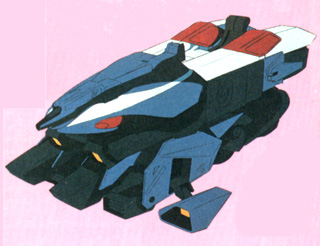 RUNNING, SOLDIER
CONFIGURATION:
RUNNING, SOLDIER
CONFIGURATION:
- 56 kph
- LEAPING, SOLDIER CONFIGURATION:
- 15 m high or 30 m long without thrusters.
- MAX SPEED, TANK CONFIGURATION:
- 13 kph
- MAX SPEED, HOVERCRAFT CONFIGURATION :
- 161 kph with maximum sustained hover height of 2.5 meters
- DESIGNED G LIMITS:
- +12.0/-6.5 (Computer overrides at 9.5g)
- MAX ACCELERATION: SPACE
- 0.94g (although rarely used in space)
- DELTA V:
- 0.7 kps with 500 kg of D20 stored internally
- Drop Tanks count be mounted on the rear of the unit which will
provide an additional delta
v of:
- 1300 liters - 1.9 kps
- 2310 liters - 3.2 kps
- 4000 liters - 5.4 kps
STATISTICAL DATA:
- HEIGHT
- 6.2 m (battloid)
- 4.5 m (guardian)
- 2.25 m (hovertank)
- WIDTH:
- 4.4 m (battloid-breadth)
- 2.25 m (guardian)
- 2.7 m (hovertank)
- LENGTH:
- 2.0 m (battloid-depth)
- 7.75 m (guardian)
- 6.0 m (hovertank)
- WEIGHT:
- 26,400 kg empty.
- PHYSICAL STRENGTH:
- Equal to a P.S. of 60
- CARGO:
- Small compartment behind pilot's seat for personal belongings
- POWER PLANT:
- 2 x RRL-2 Miniaturized protoculture-cell energizer
- MAX ENGINE THRUST
- [Main] 4 x Pratt & Whitney HJ-800: Four
hover jets are mounted in the undercarriage of the Spartas in hovercraft mode
or in the bottoms of the feet in battloid and tank providing 71 kN of
ground-effect thrust each.
- [Auxiliary]
2 x Turbo-Union ATF-480 miniaturized fusion plasma-air/reaction mass intermix
ramjets: Two fusion plasma engines
are mounted on the rear of the unit for spaceborne operations. Each engine
is rated to 63.1 kN standard
thrust, max overboost to 121.2 kN each (specific impulse of 4000 sec).
- [Auxiliary]
2 x Turbo-Union RP-2S Rocket Pods: Two rocket pods are attached
to the lower legs while the Spartas is in hovertank mode and provide
additional maneuverability for spaceborne operations. Each engine can
produce 103 kN of thrust for up to 70 seconds. These rocket pods could
be used by all models but were only intoduced into the ASC during the last
year of the 2nd Robotech War
- FUEL CAPACITY
- 8 standard canisters of protoculture
- 500 liters of D20 for reaction mass (used only for spaceborne
operations)
- COMPATIBLE FAST PACKS:
- None
WEAPON SYSTEMS:
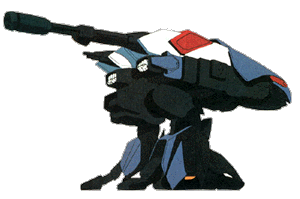
- (VHT-1) RHEINMETALL M2014 120mm LIQUID-PROPELLED SMOOTHBORE CANNON:
A single 120 mm cannon extends from the right arm-shield in tank mode. The cannon is autoloaded
at a rate of 32 rounds/minute, with 20 rounds stored in the right ammunition
bin. An additional 30 rounds may be stored in the left ammunition bin; however, the
shells have to be transferred by hand to the cannon. The mix of shells is dependent on the mission; however, the
typical anti-mecha load is: 50% HEAP, 30% MKEP/SMDM-C/FAE, 20% SPIGOT (see
table below for full description). The weapon can be used in Battloid, however
the weapon will be disconnected from the autoloader and can only fire the
shell currently loaded.
- PRIMARY PURPOSE: Assault/Defense
- SECONDARY PURPOSE: Anti-Aircraft
- RANGE: Varies on Warhead
- DAMAGE: Varies on Warhead
- RATE OF FIRE: In guardian mode it can fire as many times equal to the pilots
hand to hand attacks up to eight times per melee. In battloid mode,
the autoloader will not function and the weapon can only fire the
currently loaded shell at -5 to strike.
- PAYLOAD: 20 shells in the right ammunition bin with an additional 30 in the left.
There is enough liquid propellant for 60 shots.
- NOTES: This weapon is incredibly unwieldy and can not shoot at
incoming missiles. The autoloader with
|
Ammunition |
Damage (Blast Radius) |
Range (direct/indirect) |
Other |
| High Explosive Armor Piercing -- Self Guided (HEAP-SG) |
3D6*10 (3m) |
5.0 km / 15 km |
-4 to strike moving targets, crits on 17,18,19,20 |
| Self Propelled Intelligently Guided Ordnance Thermite (SPIGOT) |
3D4*10
(2m) |
5.6 km / 18 km |
- |
| Multiple Kinetic Energy Penetrator (MKEP-SG) |
2D4*10
(5m) |
5.6 km / 18 km |
+1 to strike, crits on 19,20 |
| Seek Mecha Destroy Mecha -- Cluster (SMDM-C) |
2D4 per bomblet (10m) |
3.5 km / 10 km |
+1 to strike, Divide the total number of
mecha by the number of bomblets (10) and attack each in a random spread. |
| Hypervelocity Airburst Flechette Explosive (HAFE) |
3D6
(30m) |
4.0 km / 12 km |
+1 to strike, crits on 19,20 |
| Fuel Air Explosive (FAE) |
2D6 (100m) |
4.0 km / 12 km |
- |
| Seek Mecha Destroy Mecha -- Minefield (SMDM-M) |
1D4 per bomblet 30m |
3.5 km / 10 km |
Divide the total number of mecha by the number of
bomblets (30) and attack each in a random spread |
| Tactical Nuclear Shell |
1 kilotonne |
5.8 km / 19 km |
See Nuclear Weapon Data |
| Sensor Artillery Delivered (SAD) |
N/A (1000m) |
6.0 km / 20 km |
Seismic and Passive EM sensor and Radio link to an area |
- (VHT-1A1,-1A3) RRG mk13 220MM PULSE LASER CANNON: The RRG mk 13 extends
from the left arm shield in tank mode and from the left arm in battloid.
The cannon can fire 31.5 MJ pulses at a rate of 6 shots per melee. The maximum range is 4.2
kilometers; however, unlike the older smoothbore the RRG mk13 can not fire indirectly.
- PRIMARY PURPOSE: Assault/Defense
- SECONDARY PURPOSE: Anti-Aircraft
- RANGE: 4200m
- DAMAGE: 3D4*10 per each individual blast
- RATE OF FIRE: In guardian mode it can fire as many times equal to the pilots
hand to hand attacks up to eight shots per melee. In battloid mode, each gun can fire up to 2 times per melee at
-5 to strike
- PAYLOAD: Conditionally Unlimited. The main gun can shoot up to 60 times
within one hour or less. Unfortunately the energy drain is incredible, the dualist
uses the same energy generator as the standard hovertank. The particle beam cannon
recharges at a rate of 60 shots per hour.
- NOTES: This weapon is incredibly unwieldy and can not shoot at
incoming missiles.
-
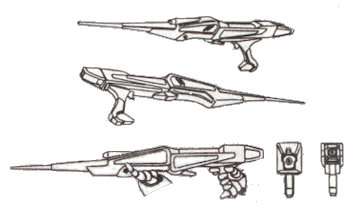 1 x MAUSER EU-11 28MM LASER GUN POD: A Mauser EU-11 can be carried in either arm while the
Spartas is in battloid mode or mounted on the front of the mecha while in
hovertanks mode. The EU-11 is powered directly from the main
protoculture and is capable of firing 13.5 MJ short bursts out to an effective
combat range of 3.5 km.
1 x MAUSER EU-11 28MM LASER GUN POD: A Mauser EU-11 can be carried in either arm while the
Spartas is in battloid mode or mounted on the front of the mecha while in
hovertanks mode. The EU-11 is powered directly from the main
protoculture and is capable of firing 13.5 MJ short bursts out to an effective
combat range of 3.5 km.
- PRIMARY PURPOSE: Assault
- SECONDARY PURPOSE:
Anti-mecha
- RANGE: 3500 m
- DAMAGE: 1D6*10 per short burst
- RATE OF FIRE: Single shots or bursts equal to
the number of hand-to-hand attacks
- PAYLOAD: Effectively unlimited
- NOTES: The weapon is not capable of firing while in
hovertank mode
- 1 x OERLIKON
TRIPLE BARREL 36MM PULSE PLASMA BEAM CANNON: A single Oerlikon 36mm pulse cannon
is mounted in the left armshield. The Oerlikon can fire 5 MJ bursts of
plasma annihilation discs, similar to that found on Invid mecha, out to an
effective combat range of 1.2 km. The weapon is powered directly from
the main protoculture energizers with plasma taken directly from the protoculture
cell energizers with each weapon storing enough plasma for up to 20 short
bursts per minute.
- PRIMARY PURPOSE: Assault
- SECONDARY PURPOSE: Anti-Mecha
- RANGE: 1200 m
- DAMAGE: 6D6 MDC per short burst
- RATE OF FIRE: Short bursts equal to the number of
hand-to-hand attacks of the pilot
- PAYLOAD: Effectively unlimited, up to 20 short bursts per
minute
- HAND TO HAND COMBAT: If necessary, the VHT-1 can engage in melee combat rather
than use a weapon..
- Restrained punch: 3D4
- Full Punch: 6D6
- Power Punch: 6D6+18
- Kick: 6D6
- Leap Kick: 6D6
- Body Block/Tackle: 6D6.
- Stomp: 3D4 MDC (only effective against small objects)
STANDARD EQUIPMENT FOR VHT-1 "SPARTAS":
-
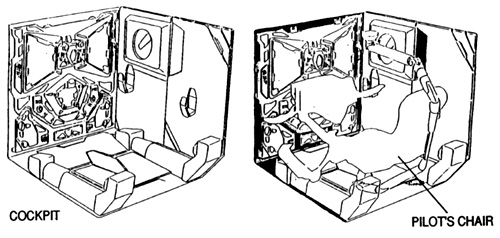 ACTIVE SENSOR
JAMMER: Westinghouse
ALQ-250(V) internal ECM providing broadband protection. Estimated
system effective radiative power 50 dBW
ACTIVE SENSOR
JAMMER: Westinghouse
ALQ-250(V) internal ECM providing broadband protection. Estimated
system effective radiative power 50 dBW
- AUTO-PILOT: The Spartas is equipped with a computerized
auto-pilot, allowing the pilot to relax or even sleep during long
voyages. The auto- pilot can be programmed with a single destination or
a complex flight plan involving multiple speeds, directions, and
destinations. The onboard computer will alert the pilot when the
fighter is near its destination, and can also be set to automatically
signal when sensors detect objects near the mecha. The auto-pilot was
designed with long intra-system space journeys in mind.
- COMBAT COMPUTER: The IBM-210 combat computer tracks and
identifies specific enemy targets, and has a database of over 10,000
images stored in memory. The computer can identify and track up to 250
targets simultaneously.
- EXTERNAL AUDIO PICKUP: Range: 300 ft (91.5 m). A sound
amplification system that can pick up normal conversation up to 300
feet away.
- HEAT AND RADIATION SHIELDS: Special shielding prevents the
penetration of life threatening head and radiation. A radiation
detection and alarm system are linked with the shields and will sound
an alarm if there is a rupture in the shields and what the levels of
radiation are.
- HOMING SIGNAL: The VHT-1 is equipped with a homing
device that enables rescue teams to locate a disabled craft or ejected
life pod. The range of the signal is 400 miles (640 km). Most REF ships
and veritechs can locate and track a homing signal, and the onboard
computers will automatically notify their pilots if such a signal is
detected.
- INFRA-RED COUNTERMEASURES: Westinghouse QRC-100
providing protection from IR guided missiles
- INFRA-RED WARNING RECEIVER: OlDelft Infra-red
Warning Receiver (IRWR) providing rear aspect coverage from IR guided
missiles
- LASER COMMUNICATIONS: Long range, directional communication system. Effective
range: 100,000 miles
- LASER RANGE FINDER / TARGETING SYSTEM: Thomson LT-5
multi-frequency laser ranger and designator (Range 30 kilometers)
- LOUDSPEAKER: A loudspeaker system is built into the craft,
which can be used to amplify the pilot's voice up to 100 decibels.
- OPTICS (INFRARED): Phillips All-View multi-band
camera system range 1000 meters. This optical system projects a
beam of infrared light that is invisible to the normal eye, but
detectable by the mecha's sensors. The system allows the pilot to
detect hidden/concealed objects by their IR reflectiveness. The beam
will be visible to anyone with IR sensitive optics, however.
- OPTICS (NIGHTVISION): Phillips All-View multi-band camera
system range 1000 meters. A passive light image intensifier that
emits no light of its own, but relies on ambient light which is
electronically amplified to produce a visible picture.
- OPTICS (THERMAL IMAGER): Phillips All-View
multi-band camera system range 1000 meters. A passive optical heat
sensor that detects infrared radiation projected by warm objects and
converts that data into a false-color visible image. The system enables
the pilot to see in the dark, in shadows, and through smoke, and also
adds a +10% bonus to pilots using a tracking skill.
- RADIO/VIDEO COMMUNICATION: Long range, directional
communications system with satellite relay capabilities. Range: 600
miles (960 km) or can be boosted indefinitely via satellite relay.
- RADAR (SHORT RANGE / FIRE CONTROL): Westinghouse
TPG-113
X-band pulse-Doppler, providing spherical long-range detection and
tracking of targets at all altitudes. (Range 40 km against a 0 dBsm
"Invid sized" target)
- RADAR WARNING RECEIVER: Marconi Radar Warning
Receiver (RWR)
- SELF-DESTRUCT: To prevent capture of an advance variable
fighter by the enemy, the pilot can activate the VHT-1
self-destruct system, which will cause the fighter to explode after a
delay of up to 60 minutes (time is set by the pilot). The explosive
damage is contained within a 20 foot (6 m) area and inflicts 1D6*10
M.D. to everything within the radius of the explosion. All internal
systems are obliterated. The pilot will be automatically ejected
prior to the explosion unless the pilot overrides the ejection
sequence.
- STANDARD SURVIVAL KIT: All Southern Cross veritechs come equipped
with a portable survival kit. Inside the small reinforced box is a
medium-sized flashlight, two hand flares, one rocket flare, a compass,
infrared distancing binoculars, a small mirror, a pocket knife,
dehydrated and concentrated food (can be stretched into a five day
supply for one person) and basic first aid items (aspirin, bandages,
disinfectants, etc.)
- TACTICAL LIFE SUPPORT SYSTEM: The VHT-1 cockpit is
pressurized, and also provides additional air feeds to the pilot's
flight suit that provides him with pressurized breathing. The Southern Cross
flight suit also contains an upper and lower g-suit that promotes blood
circulation even during high-g turns, thus decreasing the possibility
of pilot's blacking out in combat.
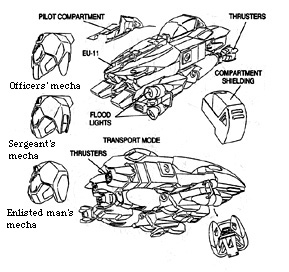 COMBAT BONUSES FOR VHT-1(-1A2) "SPARTAS" COMBAT TRAINING:
COMBAT BONUSES FOR VHT-1(-1A2) "SPARTAS" COMBAT TRAINING:
- 3 attacks per melee (plus those of
the pilot)
- Add one additional action/attack at levels five and ten
- +2 to strike
- +4 to parry
- +3 to dodge in battloid, +0 in hovertank, and +4 in hovercraft
- +3 to roll with a punch or fall with an impact, reducing damage
by half
- Critical strike same as pilot's hand-to-hand
COMBAT BONUSES FOR VHT-1A1(-1A3) "SPARTAS" COMBAT TRAINING:
- 3 attacks per melee (plus those of
the pilot)
- Add one additional action/attack at levels six and eleven
- +1 to strike
- +3 to parry
- +2 to dodge in battloid, +0 in tank, and +3 in hovercraft
- +3 to roll with a punch or fall with an impact, reducing damage
by half
- Critical strike same as pilot's hand-to-hand
COMBAT BONUSES FOR VHT-1(-1A1,-1A2,-1A3) "SPARTAS" BASIC TRAINING:
- 1 attacks per melee (plus those of
the pilot)
- Add one additional action/attack at levels seven and thirteen
- +0 to strike
- +1 to parry
- +1 to dodge in battloid, +0 in hovertank, and +2 in hovercraft
- +1 to roll with a punch or fall with an impact, reducing damage
by half
- Critical strike same as pilot's hand-to-hand
Random Hit Locations
When there is an equal chance of
hitting both sides from 1D6
- 1-3 hits the right side
- 4-6 hits the left
When there is a preferred side, roll
1D10
- 1-8 hits the preferred side
- 9-10 hits the opposite side
| Hovertank |
FRONT |
BACK |
SIDES |
TOP |
BOTTOM |
| Headlight
(Main Body) |
01-05 |
- |
01-02 |
01-02 |
- |
| Head (Main Body) |
- |
- |
- |
- |
- |
| Hands (Arms) |
- |
01-10 |
- |
- |
- |
| Arms (Main Body) |
- |
11-13 |
03-12 |
- |
01-07 |
| Arm Shields (Main/Tri
Cannons) |
06-09 |
14-25 |
13-30 |
03-18 |
08-10 |
| Legs (Main Body) |
10-16 |
- |
31-47 |
19-21 |
11-39 |
| Retractable Hover Jets
(Main Body) |
17-25 |
26-34 |
48-58 |
22-23 |
40-50 |
| Rear Hover Jets (Main
Body) |
- |
35-40 |
59-63 |
- |
51-56 |
| Main Cannons (Arms) |
- |
41-44 |
- |
24 |
- |
| Tri-auto Cannon (Arms) |
- |
45-48 |
|
25 |
- |
| EU-11 (Main Body) |
26-30 |
- |
64-66 |
26-37 |
- |
| Pilot's Compartment |
31-44 |
49-60 |
66-72 |
38-50 |
- |
| Main Body (Pilot's
Compartment) |
45-90 |
61-94 |
73-94 |
51-94 |
57-00 |
| Pilot / Armored Hood |
91-00 |
95-00 |
95-00 |
95-00 |
- |
| Guardian |
FRONT |
BACK |
SIDES |
TOP |
BOTTOM |
| Headlight
(Main Body) |
- |
- |
01-02 |
01-02 |
01-02 |
|
Head (Main Body) |
- |
- |
- |
- |
03-05 |
| Hands (Arms) |
01-05 |
- |
- |
- |
- |
| Arms (Main Body) |
06-10 |
01-05 |
03-15 |
- |
06-17 |
| Arm Shields
(Main/Tri Cannons) |
11-25 |
06-10 |
16-37 |
03-25 |
18-19 |
| Legs (Main Body) |
26-49 |
11-33 |
38-50 |
- |
20-45 |
| Retractable Hover Jets
(Main Body) |
- |
- |
- |
- |
- |
| Rear Hover Jets (Main
Body) |
- |
34-36 |
51 |
- |
46-51 |
| Main Cannons (Arms) |
50-56 |
- |
52-60* |
26-34 |
52-60 |
| Tri-auto Cannon (Arms) |
57-63 |
- |
52-60* |
35-43 |
61-69 |
| EU-11 (Main Body) |
- |
37-40 |
61-62 |
44-45 |
70-71 |
| Pilot's Compartment |
64-72 |
41-49 |
63-69 |
46-58 |
- |
| Main Body (Pilot's
Compartment) |
73-94 |
50-96 |
70-94 |
59-94 |
72-00 |
| Pilot / Armored Hood |
95-00 |
97-00 |
95-00 |
95-00 |
- |
| Battloid |
FRONT |
BACK |
SIDES |
TOP |
BOTTOM |
| Headlight
(Main Body) |
- |
- |
- |
- |
- |
|
Head (Main Body) |
01-10 |
01-10 |
01-10 |
01-10 |
|
| Hands (Arms) |
11-15 |
11-15 |
11-15 |
- |
01-06 |
| Arms (Main Body) |
16-26 |
16-26 |
16-17 |
11-19 |
07-13 |
| Arm Shields
(Main/Tri Cannons) |
27-46 |
27-46 |
18-40 |
20-36 |
14-24 |
| Legs (Main Body) |
47-61 |
47-58 |
41-60 |
37-42 |
25-59 |
| Retractable Hover Jets
(Main Body) |
- |
- |
- |
- |
- |
| Rear Hover Jets (Main
Body) |
- |
- |
- |
- |
- |
| Main Cannons (Arms) |
- |
- |
- |
- |
60-62 |
| Tri-auto Cannon (Arms) |
- |
- |
- |
- |
63-65 |
| EU-11 (Main Body) |
62-69 |
59-66 |
61-68 |
43-45 |
66-70 |
| Pilot's Compartment |
- |
67-72 |
69-70 |
46-50 |
- |
| Main Body (Pilot's
Compartment) |
70-00 |
73-00 |
71-00 |
51-00 |
71-00 |
| Pilot / Armored Hood |
- |
- |
- |
- |
- |
REFERENCES USED IN THIS DESIGN
- Palladium
Books: Book 4 "The Southern Cross"
- Robotech.com: VHT-1 "Spartas" Veritech Hovertank
- Robotech Technical Files: VHT-2 "Spartas" Veritech Hovertank
Back to
Mecha Home
 The
VHT-1 “Spartas” was developed by the United Earth Government in 2015 to fill the
armored reconnaissance role, a role which had previously been carried out by the
VBT-1 "Centaur";
however, by 2015 technological improvements had made the design dangerously
obsolete. The new design was required to have superior maneuverability over the
older RDF Destroid and VBT-1 “Centaur” models but retain the armor and firepower
to directly confront the most powerful Zentraedi mecha. Two designs were placed
forwarded as prospective candidates. The first was an upgraded version of the
venerable Centaur, dubbed the VBT-1A1 “Centaur-II” and the other was the VHT-1
“Spartas” hovertank. Although the Centaur-II provided protection for the crew
in all modes and possesses slightly greater firepower, the VHT-1 “Spartas”
ultimately won the competition with its greater maneuverability and dedicated
battloid mode.
The
VHT-1 “Spartas” was developed by the United Earth Government in 2015 to fill the
armored reconnaissance role, a role which had previously been carried out by the
VBT-1 "Centaur";
however, by 2015 technological improvements had made the design dangerously
obsolete. The new design was required to have superior maneuverability over the
older RDF Destroid and VBT-1 “Centaur” models but retain the armor and firepower
to directly confront the most powerful Zentraedi mecha. Two designs were placed
forwarded as prospective candidates. The first was an upgraded version of the
venerable Centaur, dubbed the VBT-1A1 “Centaur-II” and the other was the VHT-1
“Spartas” hovertank. Although the Centaur-II provided protection for the crew
in all modes and possesses slightly greater firepower, the VHT-1 “Spartas”
ultimately won the competition with its greater maneuverability and dedicated
battloid mode.  RUNNING, SOLDIER
CONFIGURATION:
RUNNING, SOLDIER
CONFIGURATION: 
 1 x MAUSER EU-11 28MM LASER GUN POD: A Mauser EU-11 can be carried in either arm while the
Spartas is in battloid mode or mounted on the front of the mecha while in
hovertanks mode. The EU-11 is powered directly from the main
protoculture and is capable of firing 13.5 MJ short bursts out to an effective
combat range of 3.5 km.
1 x MAUSER EU-11 28MM LASER GUN POD: A Mauser EU-11 can be carried in either arm while the
Spartas is in battloid mode or mounted on the front of the mecha while in
hovertanks mode. The EU-11 is powered directly from the main
protoculture and is capable of firing 13.5 MJ short bursts out to an effective
combat range of 3.5 km.
 ACTIVE SENSOR
JAMMER: Westinghouse
ALQ-250(V) internal ECM providing broadband protection. Estimated
system effective radiative power 50 dBW
ACTIVE SENSOR
JAMMER: Westinghouse
ALQ-250(V) internal ECM providing broadband protection. Estimated
system effective radiative power 50 dBW COMBAT BONUSES FOR VHT-1(-1A2) "SPARTAS" COMBAT TRAINING:
COMBAT BONUSES FOR VHT-1(-1A2) "SPARTAS" COMBAT TRAINING: